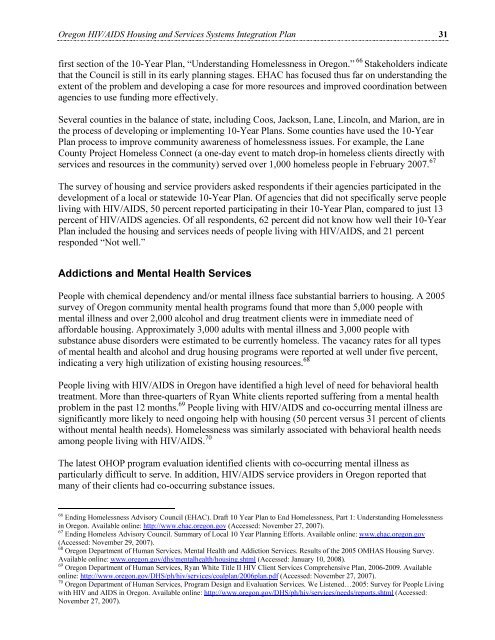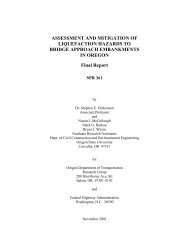Oregon Balance of State HIV/AIDS Housing & Services Systems ...
Oregon Balance of State HIV/AIDS Housing & Services Systems ...
Oregon Balance of State HIV/AIDS Housing & Services Systems ...
You also want an ePaper? Increase the reach of your titles
YUMPU automatically turns print PDFs into web optimized ePapers that Google loves.
<strong>Oregon</strong> <strong>HIV</strong>/<strong>AIDS</strong> <strong>Housing</strong> and <strong>Services</strong> <strong>Systems</strong> Integration Plan 31<br />
first section <strong>of</strong> the 10-Year Plan, “Understanding Homelessness in <strong>Oregon</strong>.” 66 Stakeholders indicate<br />
that the Council is still in its early planning stages. EHAC has focused thus far on understanding the<br />
extent <strong>of</strong> the problem and developing a case for more resources and improved coordination between<br />
agencies to use funding more effectively.<br />
Several counties in the balance <strong>of</strong> state, including Coos, Jackson, Lane, Lincoln, and Marion, are in<br />
the process <strong>of</strong> developing or implementing 10-Year Plans. Some counties have used the 10-Year<br />
Plan process to improve community awareness <strong>of</strong> homelessness issues. For example, the Lane<br />
County Project Homeless Connect (a one-day event to match drop-in homeless clients directly with<br />
services and resources in the community) served over 1,000 homeless people in February 2007. 67<br />
The survey <strong>of</strong> housing and service providers asked respondents if their agencies participated in the<br />
development <strong>of</strong> a local or statewide 10-Year Plan. Of agencies that did not specifically serve people<br />
living with <strong>HIV</strong>/<strong>AIDS</strong>, 50 percent reported participating in their 10-Year Plan, compared to just 13<br />
percent <strong>of</strong> <strong>HIV</strong>/<strong>AIDS</strong> agencies. Of all respondents, 62 percent did not know how well their 10-Year<br />
Plan included the housing and services needs <strong>of</strong> people living with <strong>HIV</strong>/<strong>AIDS</strong>, and 21 percent<br />
responded “Not well.”<br />
Addictions and Mental Health <strong>Services</strong><br />
People with chemical dependency and/or mental illness face substantial barriers to housing. A 2005<br />
survey <strong>of</strong> <strong>Oregon</strong> community mental health programs found that more than 5,000 people with<br />
mental illness and over 2,000 alcohol and drug treatment clients were in immediate need <strong>of</strong><br />
affordable housing. Approximately 3,000 adults with mental illness and 3,000 people with<br />
substance abuse disorders were estimated to be currently homeless. The vacancy rates for all types<br />
<strong>of</strong> mental health and alcohol and drug housing programs were reported at well under five percent,<br />
indicating a very high utilization <strong>of</strong> existing housing resources. 68<br />
People living with <strong>HIV</strong>/<strong>AIDS</strong> in <strong>Oregon</strong> have identified a high level <strong>of</strong> need for behavioral health<br />
treatment. More than three-quarters <strong>of</strong> Ryan White clients reported suffering from a mental health<br />
problem in the past 12 months. 69 People living with <strong>HIV</strong>/<strong>AIDS</strong> and co-occurring mental illness are<br />
significantly more likely to need ongoing help with housing (50 percent versus 31 percent <strong>of</strong> clients<br />
without mental health needs). Homelessness was similarly associated with behavioral health needs<br />
among people living with <strong>HIV</strong>/<strong>AIDS</strong>. 70<br />
The latest OHOP program evaluation identified clients with co-occurring mental illness as<br />
particularly difficult to serve. In addition, <strong>HIV</strong>/<strong>AIDS</strong> service providers in <strong>Oregon</strong> reported that<br />
many <strong>of</strong> their clients had co-occurring substance issues.<br />
66<br />
Ending Homelessness Advisory Council (EHAC). Draft 10 Year Plan to End Homelessness, Part 1: Understanding Homelessness<br />
in <strong>Oregon</strong>. Available online: http://www.ehac.oregon.gov (Accessed: November 27, 2007).<br />
67<br />
Ending Homeless Advisory Council. Summary <strong>of</strong> Local 10 Year Planning Efforts. Available online: www.ehac.oregon.gov<br />
(Accessed: November 29, 2007).<br />
68<br />
<strong>Oregon</strong> Department <strong>of</strong> Human <strong>Services</strong>, Mental Health and Addiction <strong>Services</strong>. Results <strong>of</strong> the 2005 OMHAS <strong>Housing</strong> Survey.<br />
Available online: www.oregon.gov/dhs/mentalhealth/housing.shtml (Accessed: January 10, 2008).<br />
69<br />
<strong>Oregon</strong> Department <strong>of</strong> Human <strong>Services</strong>, Ryan White Title II <strong>HIV</strong> Client <strong>Services</strong> Comprehensive Plan, 2006-2009. Available<br />
online: http://www.oregon.gov/DHS/ph/hiv/services/coalplan/2006plan.pdf (Accessed: November 27, 2007).<br />
70<br />
<strong>Oregon</strong> Department <strong>of</strong> Human <strong>Services</strong>, Program Design and Evaluation <strong>Services</strong>. We Listened…2005: Survey for People Living<br />
with <strong>HIV</strong> and <strong>AIDS</strong> in <strong>Oregon</strong>. Available online: http://www.oregon.gov/DHS/ph/hiv/services/needs/reports.shtml (Accessed:<br />
November 27, 2007).

















